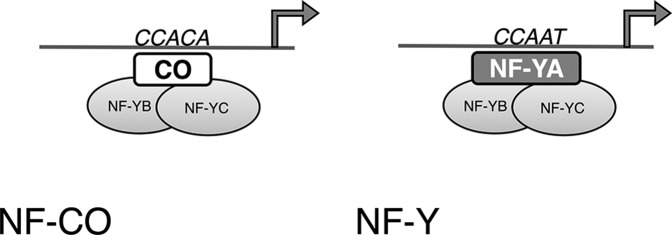One of the central players in the complex regulation of flowering, CONSTANS (CO), functions as a center for integration of the various signals that determine the timing of flowering. As output, CO regulates the expression of FLOWERING LOCUS T (FT) and other genes (reviewed in Shim et al., 2017). CO contains a CCT (CONSTANS, CONSTANS-LIKE, TOC1) domain similar to the conserved domain in NF-YA, a subunit of the Nuclear Factor-Y (NF-Y) transcription factor complex. NF-Y binds to a CCAAT box in the FT promoter and CO binds to a CO-responsive element (CORE) in the FT promoter.
NF-Y contains three subunits; two of these subunits, NF-YB and NF-YC, contain histone fold domains and interact through these domains to form a dimer, analogous to the dimer formed by histones H2B and H2A. The third subunit, NF-YA, binds this dimer and provides sequence specificity for binding to the CCAAT box. Animal genomes generally encode only one or two versions of each subunit and plant genomes have about a dozen genes for each subunit. Many of these genes have diverged in expression pattern but show strong conservation of the histone fold domain and a stretch in NF-YA required for sequence-specific binding of DNA and binding the histone fold domain.
Work in Arabidopsis thaliana showed that NF-YB and NF-YC physically interact with CO. To examine whether CO forms a trimeric complex analogous to NF-Y, Gnesutta et al. (2017) conducted electrophoretic mobility shift assays (EMSAs) with the purified CO CCT domain, Arabidopsis NF-YB2 and NF-YC3, and a probe with the FT CORE2 sequence. Indeed, the EMSAs showed that CO plus NF-YB2/NF-YC3 bound the CORE2 specifically and did not bind the CCAAT box and that CO alone showed little or no binding to CORE2. The authors named the CO/NF-YB2/NF-YC3 complex the NF-CO complex.
Model for the NF-CO and NF-Y complexes. Association of NF-YB and NF-YC subunits with either CO or NF-YA gives sequence-specific DNA binding. (Reprinted and modified from Gnesutta et al. [2017], Figure 8.)
The authors next examined the preferred binding sequences of NF-CO. To this end, they examined the ability of mutant probes to compete for binding to the NF-CO complex in EMSAs and found that this complex prefers to bind the CORE element CCACA, with specific flanking sequences. The authors used RNA-sequencing analysis of co-sail, nf-yb, and nf-yc mutants to identify the genes potentially regulated by NF-CO, which included FT (as expected) and circadian regulation genes such as GIGANTEA; this analysis also refined the definition of the matrix of sequences NF-CO can potentially bind. Intriguingly, some genes that showed alterations in nf-yb and nf-yc mutants did not show alterations in the co-sail mutants, indicating that other proteins with CCT domains might interact with these NF-CO subunits. The Arabidopsis thaliana genome encodes 40 proteins with predicted CCT domains, indicating many potential binding partners for NF-YB/NF-YC. Coimmunoprecipitation assays in the various mutants also showed that CO did not bind to the FT promoter in the absence of NF-YB2 and NF-YB3.
In the NF-Y complex, NF-YA interacts with a region formed by specific α-helices of NF-YB and NF-YC. Analysis of NF-YB2 and NF-YC3 mutations in amino acids that are important for heterotrimer formation in NF-Y showed that these mutations affected formation of NF-CO, indicating that CO and NF-YA may bind to NF-YB/NF-YC in a similar way. Likewise, mutation of a conserved amino acid in CO abolished binding to CORE2. The similarities of binding indicate that CO and NF-YA might compete for binding, providing a possible explanation for the observation that overexpression of some NF-YAs can affect flowering, and yet another cautionary tale for interpretation of experiments involving protein overexpression.
The large number of different NF-Y subunits, binding sites, and CCT domain-containing proteins presents a staggering number of potential complexes. Untangling their combinatorial activities and the multitude of processes where these complexes act is an exciting possibility for future research.
Footnotes
Articles can be viewed without a subscription.
References
- Gnesutta N., Kumimoto R.W., Swain S., Chiara M., Siriwardana C., Horner D.S., Holt B.F. III, Mantovani R. (2017). CONSTANS imparts DNA sequence-specificity to the histone-fold NF-YB/NF-YC dimer. Plant Cell 29: 1516–1532. [DOI] [PMC free article] [PubMed] [Google Scholar]
- Shim J.S., Kubota A., Imaizumi T. (2017). Circadian clock and photoperiodic flowering in Arabidopsis: CONSTANS is a hub for signal integration. Plant Physiol. 173: 5–15. [DOI] [PMC free article] [PubMed] [Google Scholar]



